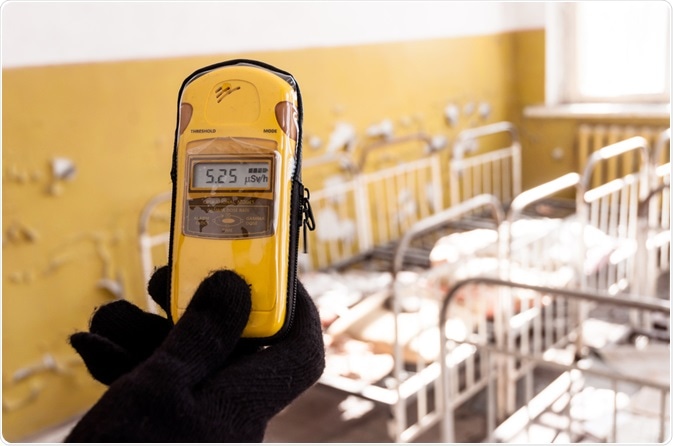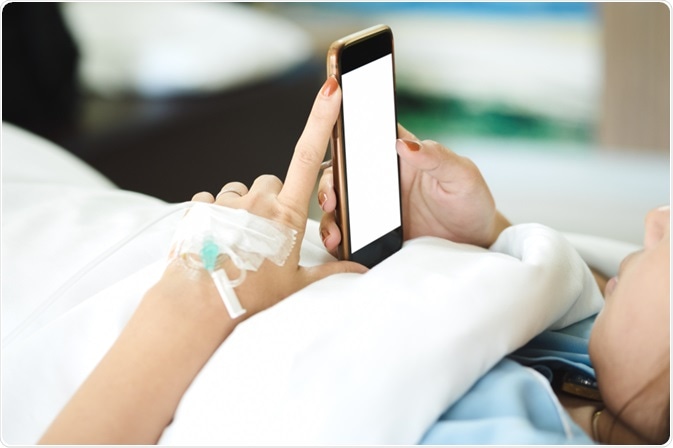In cases of mass exposure to ionizing radiation, it is important to be able to quickly determine individual levels of exposure among the casualties so that appropriate medical intervention can be applied as soon as possible. A rapid, simple method for obtaining a suitable sample and carrying out analysis is therefore vital for improving the clinical outcome for affected individuals1.
In such triage situations, the level of absorbed radiation can be gauged by subjecting a sample of human tissue, such as bone or tooth enamel to electron paramagnetic resonance (EPR).

Image Credit: SvedOliver / Shutterstock.com
The acquisition of such samples for ex-vivo dosimetry analyses is challenging and the possibility of using tissues that can be accessed less invasively has been investigated; for example, radiation levels in nail clippings. Unfortunately, in this instance, the data was confounded by water and light exposure and the mechanical cutting of the samples3.
Radiation exposure has been successfully determined in the glass test tubes used for blood collection using electron paramagnetic resonance4. The illegal omission of radiation sterilization of the blood can be detected for up to a year after exposure.
This led to artificial materials amongst the personal belongings of individuals exposed to radiation being investigated as potential targets for dosimetric analysis.
The suitability of a range of commonly carried items containing glass elements has been investigated as potential radiation dosimeters5. With the almost ubiquitous use of mobile phones, the glass screens of these devices are now being evaluated for use in accident dosimetry analysis6.
Assessing levels of ionizing radiation
Electron paramagnetic resonance can be used to study materials with unpaired electrons. It is analogous to nuclear magnetic resonance (NMR) but, rather than the spins of atomic nuclei being excited to a higher energy level, it is the electron spins that are excited. Electron paramagnetic resonance has therefore proved to be a valuable tool for the retrospective, non-destructive evaluation of radiation exposure.
The technique has been widely studied in dosimetry as a means of determining levels of radiation in constituents of the human body. With the development of several novel treatments, which could be beneficial to individuals exposed to high levels of radiation, such as stem cell transplantation, it is important to be able to assess whether such treatments are needed as soon as possible after exposure.
In order to be able to assess the level to which an individual has been exposed to ionizing radiation, it is necessary to know the time dependence of the dosimetric signals measured in tissue samples or personal belongings. Furthermore, the impact of water, such as rainfall, and light on the sample as well as mechanical stress imposed during the preparation of the sample, must be determined.
Such studies have been conducted in a range of human tissues and glass products1,5. Today there is increasing focus on the evaluation of the glass in mobile phone screens as dosimeters6.

Image Credit: AePatt Journey / Shutterstock.com
Using mobile phone screen glass as a dosimeter
EPR spectra of glass from mobile phones have been shown to change shape after irradiation7. Characterizing these radiation-induced EPR signals would allow radiation exposure to be determined from the analysis of mobile phone screen glass. This can be readily and non-invasively obtained from victims of accidental exposure to ionizing radiation as the majority of people now carry a mobile phone.
Consequently, it would be a valuable dosimeter and calibration has been described for glasses from a range of different mobile phones8,9. For mobile phone glass to be an accurate dosimeter, background radiation values must also be known.
A recent study evaluated both background and dosimetric EPR signals in samples of mobile phone touch screen glass sheets and tempered glass screen protectors10. The glass samples were obtained from a range of mobile phones incorporating different types of glass and analyzed using EPR spectra obtained with a Bruker EMX 6/1 in X band at room temperature. The Bruker marker ER 4119HS-2100 was used as the internal reference sample for all measurements.
The results showed that glass screens from mobile phones represent a good detector material for use in accident dosimetry. The EPR signals, both background, and radiation-induced, were resistant to water and mechanical stress. Although the signal decaying over time, evaluation of radiation exposure was still possible 18 months after irradiation.
The variability in background signals between different glass samples, however, would limit the accuracy of retrospective EPR dosimetry from mobile phone glass. Thus, further studies are now needed to quantify this.
References
- Trompier F, et al. Overview of physical dosimetry methods for triage application integrated in the new European network RENEB. Int J Radiat Biol 2017;93(1):65–74.
- Kinoshita A, et al. Electron spin resonance (ESR) dose measurement in bone of Hiroshima A-bomb victim. PLOS One 2018. https ://doi.org/10.1371/journal.pone.01924 44
- Marciniak A, et al. EPR dosimetry in nail samples irradiated in vivo during total body irradiation procedures. Radiat Meas 2018;116:24–34.
- Bortolin E, et al. Detection of ionizing radiation treatment in glass used for healthcare products. Radiat Prot Dosim 2019. https ://doi.org/10.1093/ rpd/ncz01 4.
- Trompier F, et al. Overview of physical and biophysical techniques for accident dosimetry. Radiat Prot Dosim 2011;144(1–4):571–574.
- Trompier F, et al. EPR dosimetry of glass substrate of mobile phone LCDs. Radiat Meas 2011;46:827–831
- Trompier F, et al. Radiation-induced signals analysed by EPR spectrometry applied to fortuitous dosimetry. Ann Inst Super Sanita 2009;45(3):287–296.
- Sholom S, McKeever SWS. Developments for emergency dosimetry using components of mobile Phones. Radiat Meas 2017;106:416–422.
- Fattibene P, et al. EPR dosimetry intercomparison using smart phone touch screen glass. Radiat Environ Biophys 2014;53(2):311–320.
- Juniewicz M, et al. Time evolution of radiation‑induced EPR signals in different types of mobile phone screen glasses. Radiation and Environmental Biophysics 2019. https://doi.org/10.1007/s00411-019-00805-1
About Bruker BioSpin
 Bruker BioSpin offers the world's most comprehensive range of NMR and EPR spectroscopy and preclinical research tools. Bruker BioSpin develops, manufactures and supplies technology to research establishments, commercial enterprises and multi-national corporations across countless industries and fields of expertise.
Bruker BioSpin offers the world's most comprehensive range of NMR and EPR spectroscopy and preclinical research tools. Bruker BioSpin develops, manufactures and supplies technology to research establishments, commercial enterprises and multi-national corporations across countless industries and fields of expertise.